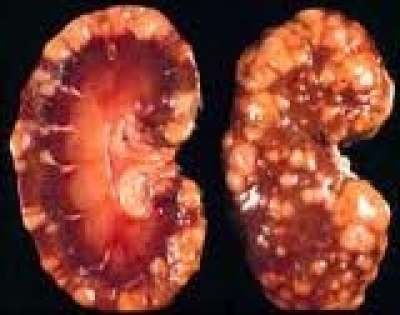
Multicystic dysplastic kidney (MCDK) is a condition that results from the malformation of the kidney during fetal development. The kidney consists of irregular cysts of varying sizes and has no function. Multicystic dysplastic kidney is the most common type of renal cystic disease, and it is one of the most common causes of an abdominal mass in infants.
Signs and symptoms
When a diagnosis of multicystic kidney is made in utero by ultrasound, the disease is found to be bilateral in 19% to 34% of cases. Those with bilateral disease often have other severe deformities or polysystemic malformation syndromes. In bilateral cases, the newborn has the classic abnormal facies and oligohydramnios characteristic of Potter's syndrome. The bilateral condition is incompatible with survival, although one infant reportedly survived for 69 days.
The contralateral system frequently is abnormal as well. Contralateral ureteropelvic junction obstruction is found in 3% to 12% of infants with multicystic kidney and contralateral vesicoureteral reflux is seen even more often, in 18% to 43% of infants . Because the high incidence of reflux, voiding cystourethrography usually has been considered advisable in all newborns with a multicystic kidney.
Cystic dysplasia of the testes, a benign rare lesion of the rete testis, may be associated with an ipsilateral multicystic dysplastic kidney.
Hypertension can complicate the clinical course. Malignant transformation to Wilm's tumor has been reported.
Diagnosis
MCDK is usually diagnosed by ultrasound examination before birth. Mean age at the time of antenatal diagnosis is about 28 weeks, with a range of 21 to 35 weeks. DMSA scan shows no uptake in affected kidney.
Treatment
MCDK is not treatable. However, the patient is observed periodically for the first few years during which ultrasounds are generally taken to ensure the healthy kidney is functioning properly and that the unhealthy kidney is not causing adverse effects. In some cases like renal hypertension or malignant transformation, the unhealthy kidney is removed entirely.

